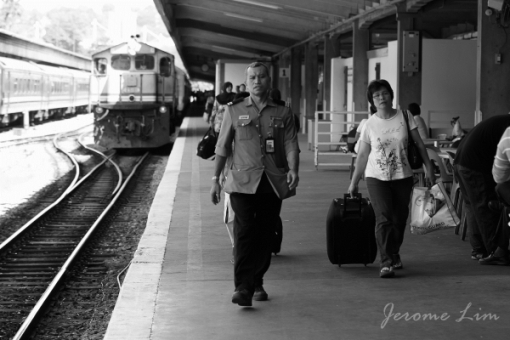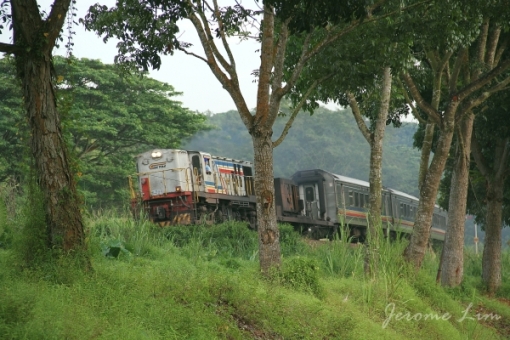I took a walk the morning after the party along the corridor that welcomed the last train to pull into Tanjong Pagar which became the last ever Malayan Railway train that the same crowd waved into the darkness of the night. It was a walk to take in a wonderfully fresh and green world that close to eight decades of the railway corridor as we know today had given to us. It is a world that I had become first acquainted with from my numerous journeys on the trains that we now see no more, a world apart from the modern world we have since become comfortable finding a fit into. It is a world that I for one often chose to escape to. The station at Bukit Timah and the area around it being a stretch of the corridor, that in its relative obscurity, has often provided me with a welcome respite from the hectic world that lay just 200 metres away down a narrow path from the station. What is to become of this wonderful world now that we have sent the last of the trains through it off, we don’t now know, but there are certainly many who wish to see that the charm of the green world that lines the corridor kept as it now is, providing a world that many in Singapore can as I have done run off to …

The former rail corridor provides an escape from the urban world we live in.

The greenery is a refreshing change to the grey world we live in.
The walk down the stretch that I covered started at the bridge at Holland Road through an area that is possibly one of the more scenic stretches of the corridor, leading to that quiet little building that has in the last month come alive with many hoping to bid farewell to the railway and the wonderful people who ran the railway through Singapore. As I walk through the clearing mist, I felt a surreal sense of peace, one that the air of silence of a corridor that has descended after eight decades of silence punctured by the occasional sound of steam engines, horns and whistles and more recently, the drone of the diesel engines and the air operated horns and whistles that most will now remember. The air of calmness was all encompassing and that with the cool of the morning air made the walk down that stretch especially invigorating.

The lifting mist enhanced the surreal feel to the now surreally silent corridor.
It wasn’t long before I reached the tiny building that served as Bukit Timah Railway Station … and again, the silence that greeted me was somewhat surreal, in stark contrast to the amazing and frenzied scenes of the night’s send off just eight hours before my arrival at the now silent building. The flags that fluttered from the flagpoles that stood between the station’s building and the platform were missing, the station’s door was firmly shut, as the station stood forlornly alone in a world that no longer has a use for it as a station. At the north end of the station, the sight of a burly security guard against the backdrop of the now silent station and tracks and the green Singapore Land Authority sign confirmed the station’s demise … no longer would we see that men in blue working tirelessly passing and receiving the looped piece of wirerope with a pouch at the end. With the passing of the last train in … the last of the old fashion practice of handing authority to the trains on the single stretch of track by means of the key token had also passed into history on the Malayan Railway line …

Bukit Timah Station now sits in silence and wears the forlorn look of an unwanted structure, in contrast to scenes just 8 hours before when a frenzied crowd had gathered in the dark of night to send the last train off. The building is now a conserved building.

The signs are now up … just hours after the handover and a security detail is in place.

The flags have stopped fluttering in the wind and the doors are now closed.

The security detail is provided to guard against any attempts to remove items (some of which are KTM property) from and to prevent vandalism at the station.
The passing of the trains provides what was I guess a first opportunity to walk on the bridges – something that many have risked their lives doing when the line was still active despite the warnings that have been given. Now, it is safe … as is the narrow northern stretch of the corridor lay beyond the truss bridge near Bukit Timah station. I did just that, walking the narrow 3 kilometre length towards the next truss bridge close to where the Rail Mall is. My most recent encounter with it was of course through the opened door of the train through which the rushing of greenery, the yellow of the kilometre markers and the wind blowing in my face provided me with a different perspective to the one I could now take in at leisure. The stretch is one on which work to remove the tracks would come later, with some parts of the track laid with monitoring equipment for the Downtown MRT line which is being constructed almost parallel to the old railway line. It is the sense of peace and quiet that surround me that I enjoyed, together with the wonderful green that made the walk all worthwhile … and while I do feel a deep sense of loss of a railway that I so love, I do hope to see that at least the memory of it is kept by preserving this ready made escape from the hectic world we spend too much of our time in. In news that came through on the afternoon after my walk, the URA and SLA have, in an encouraging move responded to requests by the public to allow the tracks and corridors to be explored by opening up the railway corridor for the public for 2 weeks. In the same new release, the URA and SLA are also seeking public feedback on the use of the railway land. More information can be found in the URA’s news release below.

A last look before the station is fenced off ….

The cessation of train services to Tanjong Pagar allows access for the public to the previously dangerous bridges.

A window into the wonderfully green and peaceful world beyond the road bridges at Rifle Range Road.

The fence of the former Yeo Hiap Seng factory still lines the railway corridor by Rifle Range Road.

The stretch from Rifle Range Road to Hindhede.

A colourful resident of the Green Corridor.

On top of the girder bridge over Hindhede Road – one of the bridges that would be retained.

The approach to the end point of my morning after walk …. the truss bridge near the Rail Mall.
Posts on the Railway through Singapore and on the Green Corridor:
I have also put together a collection of experiences and memories of the railway in Singapore and of my journeys through the grand old station which can be found through this page: “Journeys through Tanjong Pagar“.
Do also take a look at the proposal by the Nature Society (Singapore) to retain the green areas that have been preserved by the existence of the railway through Singapore and maintain it as a Green Corridor, at the Green Corridor’s website and show your support by liking the Green Corridor’s Facebook page. My own series of posts on the Green Corridor are at: “Support the Green Corridor“.
URA/SLA’s Press Release
1 July 2011
Public works and future plans for former railway land
The lands previously occupied by Keretapi Tanah Melayu (KTM) for railway use have been vested in the Singapore Government with effect from 1 July 2011.
As agreed with Malaysia, Singapore will remove the tracks and ancillary structures of the KTM railway and hand them over to Malaysia. The Singapore Land Authority (SLA) will commence these removal works as well as conduct maintenance works around the various railway sites shortly.
Public Can Access the Railway Tracks
Nevertheless, in response to requests for an opportunity for the public to trek along and experience the tracks, the SLA will be staging its works. From 1 Jul 2011 to 17 Jul 2011, the entire line of railway tracks will be open to public for 2 weeks, except for some localised areas.
After 17 Jul 2011, a 3km stretch of railway tracks from Rifle Range Road to the Rail Mall will continue to be open to the public till 31 Jul 2011.
As the railway tracks can be narrow and rough at certain locations, members of the public are advised to exercise caution when walking along the track.
The Tanjong Pagar Railway Station and Bukit Timah Railway Station will be closed temporarily to facilitate the moving out of the furniture and equipment by the KTM and its tenants. The SLA will also carry out maintenance works and structural inspection. More information on their re-opening will be provided to the public in due course.
Removal Works along the Railway Tracks
From 1 Jul to 17 Jul 2011, minor works will be carried out at the Bukit Timah Railway Station and the railway crossings at Kranji Road, Sungei Kadut Avenue, Choa Chu Kang Road, Stagmont Ring and Gombak Drive. Members of the public should avoid these work areas which will be cordoned off.
Works to remove the railway tracks along the rest of the former railway line, except for the 3km stretch from Rifle Range Road to the Rail Mall, will commence from 18 July 2011. The removal works include the clearance of minor buildings, sleepers, tracks, cables, gates, posts and debris around the various sites from Tanjong Pagar to Woodlands. Other items to be removed include railway equipment, such as signal lights, level crossings, controllers and traffic lights. The removal works are to be fully completed by 31 December 2011.
Due to these extensive removal works, the affected areas will be secured and cordoned off. For safety reasons, members of the public are advised to keep away from these areas whilst the removal works are ongoing.
Public Feedback Sought
The Urban Redevelopment Authority (URA) will comprehensively review and chart the development plans for the former railway lands and their surrounding areas. As part of its review, the URA will study the possibility of marrying development and greenery, such as applying innovative strategies to maintain a continuous green link along the rail corridor without affecting the development potential of the lands.
The URA welcomes feedback and ideas from the community in shaping the future development plans for the railway lands. The members of the public are invited to visit and provide their ideas at www.ura.gov.sg/railcorridor/.
Issued by:
Singapore Land Authority & Urban Redevelopment Authority





















































































































































































































































































































































